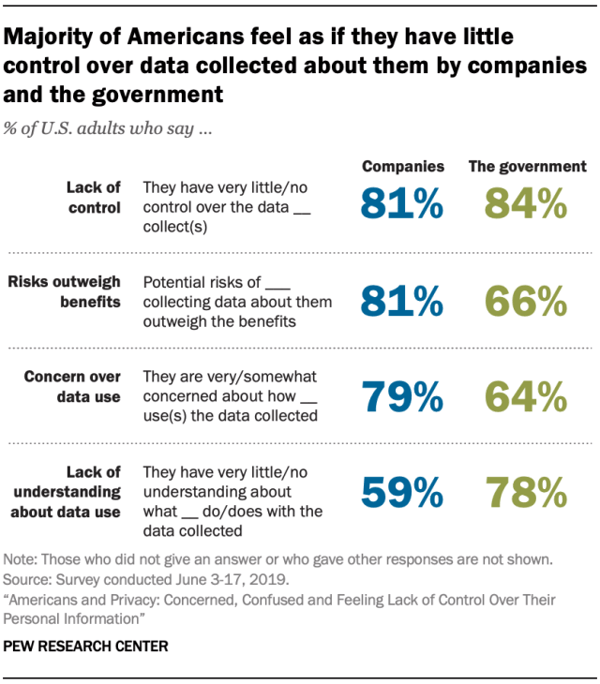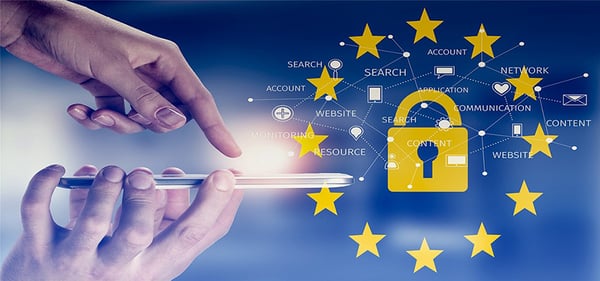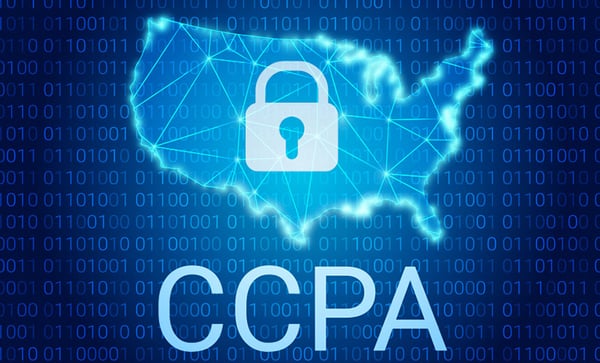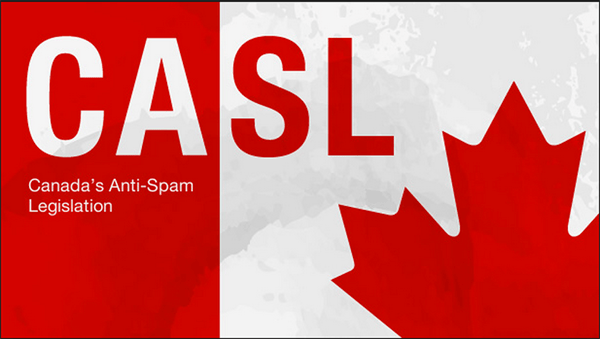Increasing your survey response rate is an invaluable way to get the invaluable feedback you need, but how do you actually get users to participate in an age when privacy and data security concerns are top of mind?
Most internet users feel like they’re always being watched—and they’re not happy about it. In a Pew survey conducted in 2019, almost 80% of American adults claimed to be “very concerned” about how companies are using their personal data.
About the same amount felt that they had little to no control over the data companies collect about them.
Over 60% feel that it’s impossible to go about their daily lives without being spied on by businesses or the government.

For nonprofits, businesses, and government entities that routinely ask people to volunteer their information, the widespread antipathy towards data collection poses a serious problem.
If you’re responsible for collecting personal information for any purpose, convincing respondents that they can trust you and your organization is more difficult than ever. How can you make people feel comfortable with answering questions and sharing their personal data so you can improve your survey response rate?
Read on for several ways to build trust and manage data securely!
Use Data Security Best Practices for Keeping Accounts Secure
What is multi factor authentication? If you’ve had to log into an account and verify your identity with a code sent to your phone, you’ve taken advantage of the security benefits of multiple credential testing.
Passwords are just one form of account security, or credentialing. Requesting at least one other type of credential means that hackers can’t gain access to users’ accounts, even if the password is compromised.

All three types of credentials — knowledge, inheritance, and possession — can be used in a multifactor authentication setup, but two-factor authentication is the most common form of multifactor authentication. It’s also widely accepted and understood by users.
For survey designers who are responsible for creating lengthier questionnaires that allow respondents to save their answers and associate them with an account, offering two-factor authentication at a minimum communicates to users that their accounts will be safe.
Explain Data Usage and Privacy Policies Clearly
Most people don’t read the full text of the privacy agreements to which they consent, in large part because those agreements are overwhelmingly long and complex.
Since the majority of users already feel like there’s no way around losing control of their personal data, they often decide that it’s not worth the trouble.

A clear, brief, and easy-to-find statement about how your organization uses data and safeguards privacy will make users feel informed and in control.
Almost all major consumer companies miss the mark on communicating with users about how their data is used, so transparency here can become a valuable point of differentiation for organizations.
Ask for Only the Data You Need
Overly lengthy surveys deter respondents from completing the entire form and decrease the quality of your data as users start to rush through questions. Unfortunately, that’s not all; they also raise suspicions about your intentions.
Some respondents, especially those who are sensitive to privacy issues, may assume that you’re harvesting psychographic data to sell to partners or use for internal marketing purposes.
To put your respondents at ease:
- Don’t collect data for its own sake.
- Avoid extraneous questions that don’t pertain to the express purpose of your survey.
- Don’t insist on making every response field mandatory.
Collecting just the information you need means that you’ll also have less data to manage, archive, and protect when your survey is complete.
Adhere to Local Privacy Laws
Where you administer a questionnaire has a substantial effect on how you have to handle data and communicate with your users. The E.U.’s General Data Protection Regulation is among the best-known—and toughest—of modern data privacy laws, but many countries, like Chile, India, and New Zealand, have passed or are considering related regulations.
 Even some states in the U.S. have passed similar privacy legislation, including the California Consumer Privacy Act. The sheer size of California’s population means that you’ll need to observe CCPA regulations if you want to collect data in the U.S.
Even some states in the U.S. have passed similar privacy legislation, including the California Consumer Privacy Act. The sheer size of California’s population means that you’ll need to observe CCPA regulations if you want to collect data in the U.S.
 [Source]
[Source]
It’s important to note that CCPA and GDPR, not to mention other laws, have unique frameworks that you should understand before you start your survey.
Before you start asking questions and collecting user data, study the requirements of each jurisdiction in which you plan to operate and make sure your site is in compliance with local laws.
 [Source]
[Source]
Proof of privacy safeguards won’t just keep your site out of trouble with legal authorities; it’ll also reassure users that you’re invested in making sure their information stays secure.
Understand Partner Privacy Policies
Since so many different types of organizations need to generate surveys, there are dozens of software tools available to speed the process.
Choices range from free options like Google Forms to dedicated services like Qualtrics and SurveyMonkey. If you’re planning on using a third-party software solution to gather information, be sure you understand how the creators of that software will handle your users’ data security.
Google Forms, for instance, falls under the Google Terms of Service agreement, which allows Google to create derivative works from that content as long as it’s used to further Google’s business objectives and not shared with a third party.
Still, if you’re collecting sensitive data, you may not want to use tools that permit anyone to own or use survey information other than you and your team.
Store Personal Data Safely
With a new high-profile data breach in the news every few months, most consumers are aware that businesses and government organizations don’t always manage to keep their personal information safe.

Worse yet, many of these data breaches aren’t the result of hyper-competent, ingenious hackers overcoming cutting-edge information security technology. Most of the issues stem from human error. Organizations postponed important software updates, left personal information on unsecured servers, and failed to lock past employees out of their network.
To maintain trust, it’s essential to get the basics of data security right and be rigorous about infosec protocols, even when they don’t seem necessary.
Offer users a simplified explanation of how your organization plans to store and handle their data. Maintaining a good reputation means avoiding all breaches and moving quickly to repair damage if respondent data is compromised.
Offering Incentives Boosts Survey Response Rates
A 2018 consumer survey by Acxiom and DMA found that 75% of Americans were willing to provide their personal data freely, as long as they felt like they would benefit from the exchange.
Although many businesses are accustomed to thinking of consumer data as something they accumulate in the normal course of business, customers likely experience information sharing as a give-and-take process.
Relatively few respondents said that they would be unwilling to share any information, even if it led to better services or improved product offerings.
You may be able to make respondents feel both more comfortable and more motivated by offering a gift card, a discount on future purchases, or other incentives. The reward you offer will depend on the reason you’re designing a questionnaire, but the strategy works for research institutions and direct-to-consumer businesses alike.
Safeguarding personal data is a serious responsibility in the information economy, and it’s more important than ever to be able to engender trust.
If you can communicate to your users that you’ll collect their data responsibly, store it securely, and offer them value for sharing with you, you’ll be able to collect greater amounts of accurate data and build a trusted reputation that will bolster your future data-gathering endeavors.
If you’re looking for more on Privacy, Security, Data, and surveying your audience, here’s what we’ve got for you:
- Article: eLearning Security: Does Cloud Hosting Measure Up?
- Webinar: The Untapped Resource for Building Better Courses: Utilizing the Feedback Module
- Webinar: How To Gauge Engagement In Your LMS Using NPS
- eBook: LMS 101: Learning Analytics
- eBook: The Practical Guide to Evaluating Your Workplace Learning Effectiveness
- Article: Learning Analytics: The Art and Science of Using Data in eLearning
Disclaimer: This article was contributed by guest blogger Kevin Gardner. Kevin graduated with a BS in Computer Science and an MBA from UCLA. He works as a business consultant for InnovateBTS where he helps companies integrate technology to improve performance. He shares his knowledge and expertise not only with his clients but with his fellow bloggers and readers.
The views and opinions expressed belong to the guest blogger alone, and do not necessarily reflect the official policies or opinions of Lambda Solutions.



